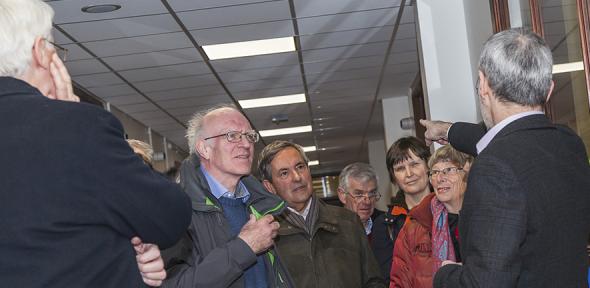
"I remember all-day practical exams. And being allowed to cook over Bunsen burners. That wouldn’t, couldn’t, happen now." Ray Jones (Trinity, 1967-73).
"I remember handling a small piece of rock from the Apollo 11 moon landing in 1969. It had been sent to Cambridge for a Mössbauer spectroscopy analysis." Geoff Royston (Christ’s, 1967-70).
"I remember an old boy telling us about his practical entrance exam in 1910 and how – when he observed a colour that identified the cation during a flame test – he immediately put his top hat over the flame (!) so other candidates could not see his test result..." Clive Bucknall (Gonville & Caius, 1954-57).
These were just some of the anecdotes we heard when we held a reunion in March for those who had been in the department up to and including 1968. The event coincided with our annual Open Day, so some of our alumni brought their children and grandchildren with them.
During the day we offered our alumni seats at Pete Wothers’ explosive lecture and private tours of the department so they could see what the labs look like now. Later, we held a drinks reception for them followed by dinner in Downing College. It was the first such reunion we have held of this kind but it won’t be the last. The alumni who came enjoyed their visit and happilyshared their memories with us and each other.
"Pushing back the tide of red ink"
Many told stories of their peers, teachers, technicians and supervisors. Jarlath Ronayne (St John’s, PhD 1965-68) recalled his supervisor, Dudley Williams, going to the University of California at Irvine as a visiting professor for a year. Jarlath, who is now Tan Sri Jeffrey Cheah Distinguished Professor at Sunway University, Malaysia says: "We corresponded by letter: I sent draft papers to him and they came back covered in red ink. I felt I was not so much pushing back the frontiers of knowledge as pushing back the tide of red ink that came from California! He taught me how to write.
Anne Butland (now Lyon) remembered "Lord Todd (Todd was God!) in the first year of my PhD coming into Lab 122 and booming ‘Where is Miss Butland?’. I was not hard to find as I was the only female in this 16-man lab...”
Meanwhile Emeritus Professor Ian Fleming told us how his own supervisor John Harley-Mason "seemed to spend the whole day walking around the Lensfield Road building. He rarely settled in one place, but was frequently to be seen in the corridors. If you needed him, the best thing to do was stay still, as he would come by soon enough."
For others, it was the building that held key memories. Roger Forder( Trinity, 1965-71) fondly remembered the Lensfield Road tearoom and the "many lively conversations (and arguments!) in it with other denizens of the organic lab.
Ralph Timms (St Catharine’s, 1961-67) recounted how the roof was used for the disposal of "unpleasant chemicals we no longer had a use for. They were taken to the roof, the sealed vial was placed in an apparatus under a hammer, with a cord attached to a release pin. We retired to a safe distance and pulled the cord; the hammer dropped, the vial broke and reacted with the air in a puff of smoke to be dispersed 'safely' over Cambridge." (How things have changed: today, unwanted chemicals leave the building rather more appropriately via the chemical waste store.)
Hair-raising health & safety matters...
And health and safety issues were a recurring theme in many alumni stories. Peter Stefanini (Trinity, 1965-71) told us about the hazards of his PhD research into Cationic Complexes of the Rarer Platinum Metals. "It required the synthesis of a chelating ligand and was quite a dangerous procedure as one began with a mole of sodium in liquid ammonia and bubbled phosphine gas through it. I very clearly remember the first time I did it. It was a Sunday and my supervisor, Dr Mays, turned up to make sure I didn’t blow myself up. But as he’d been invited to a pyjama party that afternoon, he turned up dressed in pyjamas..."
Guest of Honour at dinner in the evening was Professor Ian Fleming. He enthusiastically spoke of his support for the department, telling the audience about how he arrived as an undergraduate at Pembroke in 1956 and never left, spending his entire (very successful) academic career in Cambridge. He then regaled guests with tales of his colleagues (many of whom had taught or supervised the gathered alumni), calling out "Who else do you want to hear about?” before discussing the exceptional– or notorious – talents of the academics named by the audience. It was a convivial end to a very enjoyable day.
- In March 2019, we would like to invite alumni who were in the department in the years from 1968 to 1979, inclusive, to areunion. More details will follow closer to the event.
Image of some of our alumni touring the department courtesy of the Department of Chemistry.

